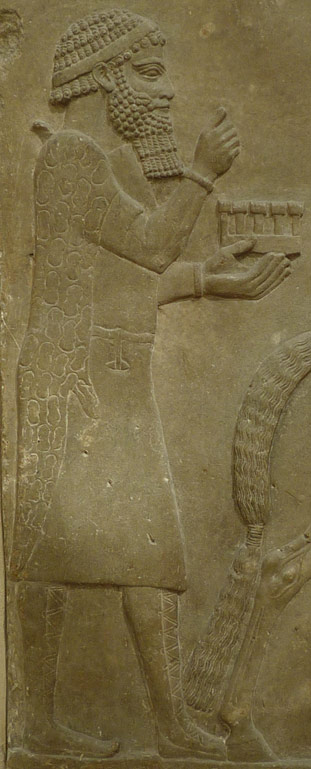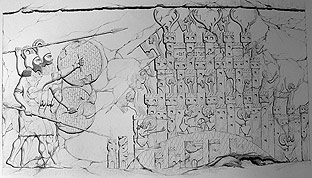The Medes, purveyors of fine horses
The second half of the 8th century BC was a period of intensive contact between Assyria and the Medes - a people who, under their king Cyaxares, conquered the city of Assur in 614 BC and, in coalition with Babylonian troops, brought about the end of the Assyrian Empire over the following years.
The Assyrian view on the Medes
From an Assyrian perspective, the various peoples living in the mountain valleys of the Zagros PGP range to the east of Assyria and south of the kingdom of Mannea, in what is today the border region between Iraq and Iran, shared many social, economic and political characteristics: they bred cattle and horses and were ruled by "city lords", a position guaranteeing hereditary leadership over a specific region with a fortified settlement as its centre. This political system was so deeply rooted in these societies that even when Assyrian provinces were established in the region in the second half of the 8th century BC, the "city lords" did not disappear.
The Assyrians identified some, but not all, of the population groups, cities and their rulers in the Zagros region as Median. Medes are well attested in the Assyrian sources from the late 9th century BC onwards and resolutely distinguished from the other peoples living in the Zagros mountain range, although what exactly made a Mede a Mede is unclear - was it language, religion, or something else entirely?
According to the Assyrian view, there was not one Median kingdom but, instead, many small independent states with no discernible sense of solidarity among them. A key reason behind this may have been the fact that these Median states all had their own commercial interests to protect: their fortresses were situated along an overland trade route of prime importance, the so-called Great Khurasan Road or Silk Road which connects Mesopotamia with central Iran, and a substantial part of their income resulted from taxing the traders travelling through and providing protection for them; putting it more negatively, we might describe the Median "city lords" as robber-barons.

Contacts between Mesopotamia and the Zagros mountain range
Steady Assyrian involvement in the Zagros mountains began in the second half of the 9th century BC when the formation of the Urartian state in Anatolia cut off the regions from which Assyria used to import horses, urgently needed for the army. Instead, western Iran became the most important source of horses for the Assyrians: horses made up most of the tribute raised from the inhabitants of the Zagros Mountains, including those of dozens of small Median city states, and provided the main motivation for Assyrian raids throughout the first half of the 8th century BC.
The Zagros region had a longstanding history of contacts with Mesopotamia. The Assyrians frequently encountered evidence of the earlier Babylonian colonisation during the mid-2nd millennium BC, such as the cities of Silhazi (also known as the "Fortress of the Babylonian"), and Til-Aššurî (meaning "Ruin mound of the Assyrian") with its Marduk temple. Whenever the Assyrian royal inscriptions make reference to sanctuaries or religious practices in the region, it is a case of encountering Mesopotamian traditions; they are completely silent in regard to any other beliefs or customs the Medes may have held.
Political and cultural contacts between Assyria and the Zagros deepened significantly when two Assyrian provinces, Parsua PGP and Bit-Hamban PGP , were founded in the region under Tiglath-pileser III (744-727 BC) in 744 BC, followed by Kar-Šarruken (Harhar PGP ) and Kar-Nergal PGP (Kišessim) under Sargon II (721-705 BC) in 716 BC, marking a new era in their relations: for the first time, Assyria directly controlled territory situated along the Iranian part of the Silk Road. As a result, the army's horse supplies were secure. There was also a pronounced increase in the Median presence in Assyria: Medes lived as members of the royal court at Kalhu under Tiglath-pileser and in significant numbers among the inhabitants of the city of Assur from at least the reign of Sargon; under Esarhaddon (681-669 BC), they are attested as bodyguards of the Assyrian royal family.

Establishing Assyrian provinces among the Medes
Retaining control over the new provinces in the Zagros proved hard work due to the persistant local resistance against the new government, yet there is no indication at all of an alliance coming together against Assyria; each small state or community seems to have fought on its own, employing guerrilla warfare against the Assyrian intruders. When the first two Assyrian provinces were established in 744 BC, one of the main responsibilities of the governor of Mazamua PGP , the eunuch Aššur-da''inanni (eponym TT of the year 733 BC), was to keep an eye on the nearby Medes, as is clear from a letter in the royal correspondence (NL 100 = SAA 19 92) and also from the fact that he led the Assyrian military campaign into the Zagros and against the Medes in 737 BC.
The situation in the two provinces, Kar-Šarruken and Kar-Nergal, which Sargon established in 716 BC, was far from stable, as the king's correspondence with his governors and vassals in the area attests (cf. SAA 15 85, SAA 15 98, SAA 15 100). In addition to the treacherous natives, the Assyrian local government suffered from the effects of the bad weather conditions in the mountains, which slowed down the construction of the necessary infrastructure, and the twin horrors of snow and cold often cut off the new provinces from communication with central Assyria (e.g. SAA 15 60, SAA 15 61, SAA 15 83).
Already in 715 BC the Assyrian army had to return to crush a rebellion of the inhabitants of the new provinces. The ensuing battle was bloody and, according to Assyrian sources, resulted in the death of 4,000 enemies and the deportation of 4,820 persons; the conquered Median strongholds were turned into Assyrian fortresses. Yet the conflict did not end with this and more Assyrian invasions followed in the following year and again in the year after. It seems clear that, at least initially, the establishment of Assyrian control suffered from the decision to leave the traditional local "city lords" in power. Despite ruling over people and areas formally considered part of the Assyrian provincial system, they were treated like vassal rulers; however, in an extraordinary concession to their influence, instead of being expected to come to central Assyria in order to pay tribute and homage to the Assyrian king, the king sent his governors to meet with these "city lords" and collect the all-important horses. Eventually, however, the dual system, with the Assyrian provincial administration on the one hand and the local "city lords" on the other, seems to have found a mutually profitable equilibrium and, after 713 BC, the troubles in Assyria's Median provinces subsided.
The Assyrian presence in the Zagros region deeply influenced the relations between the local rulers and principalities, Median and otherwise. Pro-Assyrian and anti-Assyrian leanings among the ruling elites caused various alliances and conflicts, not only with the Assyrian overlords but also among themselves. Although the Assyrian control over the Zagros provinces seems to have slipped in the course of the 7th century BC, the extant sources show that the four provinces founded by Tiglath-pileser and Sargon remained part of the Assyrian Empire at least until the reign of Esarhaddon; no sources are available for the subsequent period.

Herodotus on the early history of the Medes
What, then, of the Greek historian Herodotus' account of the early history of the Medes in his Mêdikos Logos? He credits one Deioces with uniting the six Median tribes and thereby founding a Median empire, with Ecbatana as its capital; the Medes supposedly elected him to be their king, and Herodotus goes on to trace Median history until the 6th century BC.
According to Herodotus, the Median state reached as far west as the River Halys in central Anatolia. Yet contemporary evidence for a unified Median state in the 8th and 7th centuries BC has, so far, proven elusive. On the one hand, Assyrian sources completely fail to back up Herodotus' account of the genesis of the Median empire. On the other hand, excavations at sites such as Nush-i Jan and Godin Tepe support the idea of independent small states centred around fortresses controlling the region and passage through it which emerges so clearly from the Assyrian sources, while archaeological evidence for a unified Median state stretching from Iran to inner Anatolia is conspicuously lacking. Whatever led to the recognition of Cyaxares, the conqueror of Assyria, as the "king of the Medes" by 615 BC remains tantalisingly unclear from the available sources.
Further reading:
Dalley, 'Foreign chariotry and cavalry', 1985.
Radner, 'An Assyrian view on the Medes', 2003.
Reade, 'Sargon's campaigns of 720, 716, and 715 BC', 1976.
Content last modified: 11 Feb 2013.
Karen Radner
Karen Radner, 'The Medes, purveyors of fine horses', Assyrian empire builders, University College London, 2013 [http://www.ucl.ac.uk/sargon/essentials/countries/medes/]